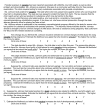Comparing attitudes about legal sanctions and teratogenic effects for cocaine, alcohol, tobacco and caffeine: a randomized, independent samples design
- PMID: 16722564
- PMCID: PMC1435999
- DOI: 10.1186/1747-597X-1-4
Comparing attitudes about legal sanctions and teratogenic effects for cocaine, alcohol, tobacco and caffeine: a randomized, independent samples design
Abstract
Background: Establishing more sensible measures to treat cocaine-addicted mothers and their children is essential for improving U.S. drug policy. Favorable post-natal environments have moderated potential deleterious prenatal effects. However, since cocaine is an illicit substance having long been demonized, we hypothesized that attitudes toward prenatal cocaine exposure would be more negative than for licit substances, alcohol, nicotine and caffeine. Further, media portrayals about long-term outcomes were hypothesized to influence viewers' attitudes, measured immediately post-viewing. Reducing popular crack baby stigmas could influence future policy decisions by legislators. In Study 1, 336 participants were randomly assigned to 1 of 4 conditions describing hypothetical legal sanction scenarios for pregnant women using cocaine, alcohol, nicotine or caffeine. Participants rated legal sanctions against pregnant women who used one of these substances and risk potential for developing children. In Study 2, 139 participants were randomly assigned to positive, neutral and negative media conditions. Immediately post-viewing, participants rated prenatal cocaine-exposed or non-exposed teens for their academic performance and risk for problems at age 18.
Results: Participants in Study 1 imposed significantly greater legal sanctions for cocaine, perceiving prenatal cocaine exposure as more harmful than alcohol, nicotine or caffeine. A one-way ANOVA for independent samples showed significant differences, beyond .0001. Post-hoc Sheffe test illustrated that cocaine was rated differently from other substances. In Study 2, a one-way ANOVA for independent samples was performed on difference scores for the positive, neutral or negative media conditions about prenatal cocaine exposure. Participants in the neutral and negative media conditions estimated significantly lower grade point averages and more problems for the teen with prenatal cocaine exposure than for the non-exposed teen beyond .0001 alpha level. The positive media program closed estimated grade point average differences and risks of later problems to a non-statistically significant margin, p >.05.
Conclusion: Ratings for prenatal cocaine were more negative than comparable ratings for alcohol, nicotine or caffeine exposure. Stereotypes can be reduced, showing viewers that positive postnatal environments ameliorate potential teratogenic effects of cocaine. Reducing negative stereotypes for crack babies may be a requisite for substantive changes in current policy.
Figures
Similar articles
-
Teacher-assessed behavior of children prenatally exposed to cocaine.Pediatrics. 2000 Oct;106(4):782-91. doi: 10.1542/peds.106.4.782. Pediatrics. 2000. PMID: 11015523
-
Growth of infants prenatally exposed to cocaine/crack: comparison of a prenatal care and a no prenatal care sample.Pediatrics. 1999 Aug;104(2):e18. doi: 10.1542/peds.104.2.e18. Pediatrics. 1999. PMID: 10429136
-
The effects of prenatal cocaine exposure on problem behavior in children 4-10 years.Neurotoxicol Teratol. 2010 Jul-Aug;32(4):443-51. doi: 10.1016/j.ntt.2010.03.005. Epub 2010 Mar 20. Neurotoxicol Teratol. 2010. PMID: 20227491 Free PMC article.
-
Potential teratogenic and neurodevelopmental consequences of coffee and caffeine exposure: a review on human and animal data.Neurotoxicol Teratol. 1994 Nov-Dec;16(6):531-43. doi: 10.1016/0892-0362(94)90032-9. Neurotoxicol Teratol. 1994. PMID: 7862054 Review.
-
Teratogen update: evaluation of the reproductive and developmental risks of caffeine.Teratology. 2001 Jul;64(1):51-78. doi: 10.1002/tera.1047. Teratology. 2001. PMID: 11410911 Review.
Cited by
-
Prevalence and Perceived Financial Costs of Marijuana versus Tobacco use among Urban Low-Income Pregnant Women.J Addict Res Ther. 2012 Sep 30;3(4):1000135. doi: 10.4172/2155-6105.1000135. J Addict Res Ther. 2012. PMID: 23858392 Free PMC article.
-
Evaluation of a Training to Reduce Provider Bias Toward Pregnant Patients With Substance Abuse.J Soc Work Pract Addict. 2014 Jul 3;14(3):239-249. doi: 10.1080/1533256X.2014.933730. J Soc Work Pract Addict. 2014. PMID: 26207103 Free PMC article.
References
-
- Paltrow LM. Perspectives of a reproductive rights attorney. Future Child. 1991;1:85–92.
-
- Heffelfinger A, Craft S, Shyken J. Visual attention in children with prenatal cocaine exposure. J Int Neuropsychol Soc. 1997;3:237–245. - PubMed
Publication types
MeSH terms
Substances
LinkOut - more resources
Full Text Sources
Medical



